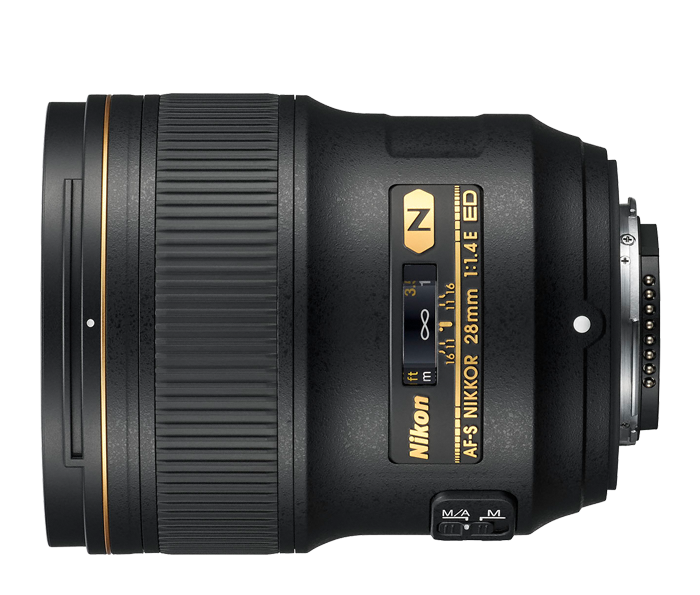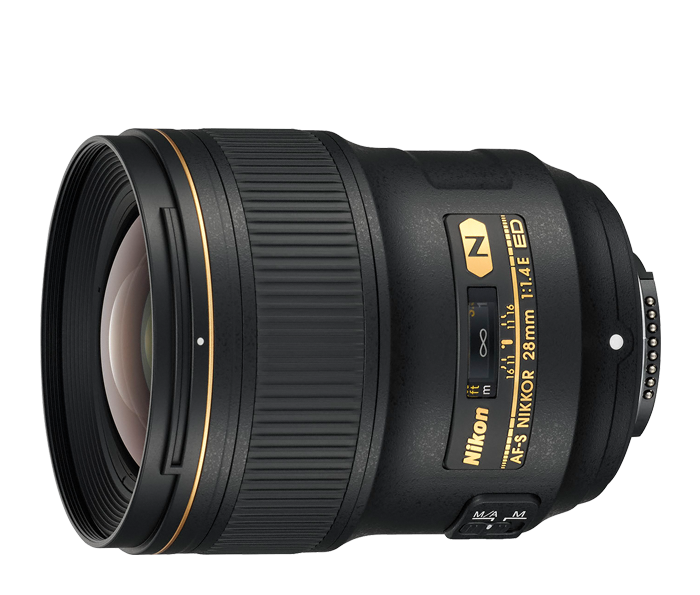Nikon AF-S NIKKOR 28mm f/1.4E ED Lens
Nikon AF-S NIKKOR 28mm f/1.4E ED Lens
- Superb 28mm prime lens with fast f/1.4 aperture for maximum depth-of-field control, beautifully blurred backgrounds and brilliant low-light performance
- Gold Ring Series optics deliver stunning sharpness, edge-to-edge clarity and virtually no distortion or aberrations
- Unwavering consistency, durable design and agile performance
Portraits and landscapes at their prime.
Introducing the latest NIKKOR prime lens worthy of wearing the coveted NIKKOR gold ring. The AF-S NIKKOR 28mm f/1.4E ED is a dynamo at capturing beautifully rich and detailed still images and movies in any light. On FX-format cameras, its fixed 28mm focal length gives your shots a natural, true-to-memory feel. Its fast maximum aperture of f/1.4 delivers beautiful depth of field with exquisite bokeh characteristics any time of the day or night, and its durable, agile design makes it a workhorse for the most passionate shooters.
Aspherical Lens
A lens with a curved, non-spherical surface. Used to reduce aberrations and enable a more compact lens size. Aspherical lenses minimize coma and other types of lens aberrations, even when used at the widest aperture. They are particularly useful in correcting distortion in wide-angle lenses and help contribute to a lighter, more compact design by reducing the number of standard (spherical) elements necessary. Aspherical lens elements correct these distortions by continuously changing the refractive index from the center of the lens.
Electromagnetic Diaphragm Mechanism
An electromagnetic diaphragm mechanism in the lens barrel provides highly accurate electronic diaphragm or aperture blade control when using auto exposure during continuous shooting. With conventional D/G type lenses, the diaphragm blades are operated by mechanical linkage levers.
ED (Extra-Low Dispersion) Glass
An optical glass developed by Nikon that is used with normal optical glass in telephoto lenses to obtain optimum correction of chromatic aberrations.
Nano Crystal Coat
An anti-reflective coating developed by Nikon that virtually eliminates internal lens element reflections across a wide range of wavelengths. Nano Crystal Coat uses ultrafine, nano-sized* crystal particles to eliminate reflections inside the lens throughout the spectrum of visible light waves (380 to 780 nm) in ways that far exceed the limits of conventional antireflection coating systems. Nano Crystal Coat not only solves ghost effects caused by red light, which was incredibly difficult for previous systems. It also effectively reduces ghost and flare effects caused by light entering the lens diagonally. The result: clearer images.
Rear Focusing System
A system in which only the rear lens group moves during focusing, thus eliminating changes in the physical length of the lens during focusing and enabling faster focusing. Such lenses are designated with RF on the lens barrel.
Super Integrated Coating
Nikon Super Integrated Coating is Nikon's term for its multilayer coating of the optical elements in NIKKOR lenses.
Silent Wave Motor
AF-S NIKKOR lenses feature Nikon’s Silent Wave Motor (SWM). This technology converts “traveling waves” into rotational energy to focus the optics. This enables high-speed autofocusing that's extremely accurate and super quiet.



